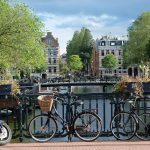Top Things to Do in Cordoba
It takes only one building to put Cordoba high on your destination list: the breathtaking multiarched Mezquita. One of the world’s greatest Islamic buildings, the Mezquita is a symbol of sophisticated culture that flourished in Cordoba more than a thousand years ago when the city was capital of Islamic Spain and the biggest town of western Europe. However, today more than the Mezquita makes Cordoba. Explore the winding, stone-paved lanes of the medieval city while emerging every few minutes on yet another little hidden plaza and make sure to remember all the things you need to do while visiting this charming city.
1) Mezquita
It’s impossible to overdescribe the beauty of Cordoba’s huge mosque, for all its remarkably serene and spacious interior. The mosque is one of the world’s greatest works of Islamic architecture, the Mezquita shows, with all its luxurious decoration, how Muslims, Jews and Christians lived side by side and enriched the city with a vibrant mixture of diverse cultures. It is one of Spain’s main cultural wonders, dating back to the 900s and the rule of Emir Abd-ar-Rahman.
2) La Judería
Cordoba’s old Jewish quarter is a network of streets where you’ll discover the bullfighting museum and a synagogue originating from the 14th century and one of the few remaining in Spain. Don’t forget to see Casa de Sefarad, a museum about Judaic-Spanish tradition through music and customs, analyzing another side of country’s turbulent religious past. This neighborhood’s history is a history of the Caliphate and of the West, whose highlights are the aforementioned synagogue and souk.
3) Alcazar de Los Reyes Cristianos
Built by Alfonso XI back at the beginning of the 14th century, the Alcazar de Los Reyes Cristianos is a Mudejar style palace with splendid gardens. It’s the place where, in the 15th century, the Catholic monarchs held court and launched their conquest of Granada. Apart from the Gardens, the highlights are the Hall of the Mosaics and a Roman stone sarcophagus dating back to the 2nd century. If you come by 09:30 a.m., you’ll make it early enough for a free entry.
4) Roman Bridge
The Roman Bridge is yet another attraction in Cordoba with a long lasting history to tell. Built under the command of the Roman emperor Augustus, the bridge was extended in 918 by the Moors to the state as you can see it today. Once part of an important Roman commercial and military route, the bridge played a major role in medieval times when people were protecting Cordoba from attacks of Peter the Cruel, so it’s safe to say that this bridge established Cordoba’s strategic importance in Andalusia and one of its fortified gates was converted to hold the Museum of Al-Andalus Life.
5) Patio de Los Naranjos
The court has a rectangular pattern of orange trees set in a grid of chapels with stone circles for each tree. It was originally painted with palm trees. However, the orange trees from which the so-called Orange Tree Court takes its name were planted in the 15th century. The fountains are still here, as is the grid of 98 orange trees that are particularly pretty and fragrant in spring when they’re in bloom. On the north west and east sides of the courtyard are arcaded galleries and if you walk along these and look up you’ll see their original delicately-carved coffered ceilings. On the south side are the 17 horseshoe arches that lead to the Mosque.
6) Calleja de Las Flores
The image of Calleja de Las Flores is found on every guidebook and for good reason. Only a short distance from the Mezquita, you’ll find some of the most beautiful patios in this tiny street. Patios are central to Cordoba’s architecture in the old quarter and present an homage to the Moorish rulers of the ancient city. For an unobstructed view, go or really early or late in the evening.
7) Centro Flamenco Fosforito
Possibly the best flamenco museum in Andalucia, the Fosforito centre has exhibits, movie displays and information panels in English and Spanish telling you everything you need to know about the history of the guitar and flamenco. Touch-screen videos demonstrate the important techniques of flamenco song, guitar, dance and percussion. You can even test your skill at beating out the compás (rhythm) of different palos (song forms). Regular free live flamenco performances are held here, too, often at noon on Sundays.
8) Mercado Victoria
The Mercado Victoria is an unusually classy food cours, which has almost everything, from Argentine empanadas and Mexican burritos to sushi and classic Spanish seafood and grilled meats, prepared right in front of your eyes. The setting is charming as well, a 19th-century wrought-iron-and-glass pavilion in the Victoria gardens just west of the old city. With beer and cocktail bars, a wine-and-cheese bar and even a nightclub, it is extremely popular with the locals all day long.
9) Medina Azahara
This Moorish city to the west of Cordoba is one of the world’s most beautiful vanity projects and it was built by Abd-ar-Rahman to put the other rules across the Islamic world in the shade. It was meant to be the capital of the Caliphate, but despite its construction of 25 years, it only stood for 65 years. It was sacked by North African Berbers and forgotten until 1911. What’s amazing is how well the site has been restored, as you pass through a mosque, marble-paved gardens, offices, bath houses, dignitary’s houses and military structures.
10) Botanical Garden
Cordoba’s Botanical Gardens opened in 1887 and were designed for primarily educational and scientific purposes. They’re laid out along a wide central alley, leading on one side to the Collections and on the other side to the Agricultural School with a large collection of citrus trees as well as extensive vegetable garden. In the centre are greenhouses dedicated to species from Andalusia, Balearic Islands and Canary Islands, as well as lovely area dedicated to the Andalusian patio.









